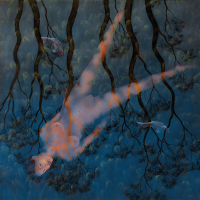81. LIN ONUS

Lin Onus is a name of growing repute and one that every Australian ought to know. He is one of the pioneers of Aboriginal contemporary art: a trailblazer who put Indigenous art on the map.1
A Melbourne-born Yorta Yorta artist, sculptor and Indigenous rights activist, Onus was the son of the well-known activist William Townsend Onus Jr (Bill Onus), a Yorta Yorta man, and Mary Kelly, of Scottish descent.
Entirely self-taught, Onus sold his first painting for $22 at the Sherbrooke Art Society Fair in 1974. Today, Onuss works are achieving soaring prices. His work is now held by the National Gallery of Australia alongside the nations leading state and regional galleries. Onuss work also enjoys a strong following among important private collectors and is featured in Bruno Raschles major international collection of Indigenous Art referred to as arguably the most important collection of Australian Indigenous art outside a public institution.2
Onuss work is instantly recognisable. His unique style combines photorealism and Western influences with Indigenous imagery, technique, and narrative. Together with Albert Namatjira (1902-1952) one of the first indigenous artists to blend native landscape with Western-style painting technique, and an influence on Onuss own work these artists are pioneers of this integrated style that continues to influence contemporary Aboriginal art.
This style is evident in The Joy of Fishing In Waiting. In the manner of photorealism, the work depicts a nude woman diagonally submerged in shallow river waters with Onuss signature inverted landscape reflected on the waters surface. The piece is one of Onuss later works, where he seamlessly integrates Indigenous narrative, imagery and spirituality with Western artistic representation and imagery. His earlier works made such dual imagery more explicit.
The reversed landscape motif features in multiple of Onuss work, including Fish and Storm Clouds (Guyi Na Ngawalngawal) 1994. The inverted, reflected background creates a work that is simultaneously flat and yet rich in depth, where the eye endlessly roams between the integrated foreground, middle ground, and background. It is a truly impressive technique and a masterful handling of reflection. Onuss inverted treescape is reminiscent of John Glovers Tasmanian landscapes and his delicate treatment of the Australian bush and gums.
The Joy of Fishing In Waiting is one of only three works in which Onus depicts a female nude. The first was Ten Little Niggers 1992, and the third, Robyn 1995. In all three, a recumbent woman is presented at a diagonal angle. This angle helps contrast the vertical lines of the native bush reflected on the waters surface. This, together with the blurred depths and layering of indigenous and Western imagery creates a sense of tension within the work.3 In each, the womans gaze is fixed on the audience, compelling us to reflect on the message submerged within the work.
Two fish can be seen on either side of the womans body. Their movement is intensified by Onuss use of rarrk to decorate them a unique crosshatching technique that Onus was permitted to use by his adoptive father and mentor, the late Djinang artist and Yulungu elder, Djiwul Jack Wunuwun (1930-1991) from the Garmedi outstation in Central Arnhem Land.4
The inclusion of this traditional style of rarrk within the image intensifies Onuss aim of juxtaposing traditional aboriginal land, culture and imagery with urbanised, non-indigenous imagery.
Onuss adoptive connection to the land and community at Maningrida revolutionised his work and enabled him to imbue his photorealistic landscapes with a rich traditional and contemporary Aboriginal imagery. The result is a unique and instantly recognisable visual language.
Activism and political comment are a significant undercurrent in Onuss work. His art is primarily about recognising and collapsing the tension between the Indigenous and the non-indigenous by drawing attention to the differences between the two and advocating for a resolution: I kind of hope that history may see me as some sort of bridge between cultures.5
Onus was heavily influenced by his fathers and mothers activism. His father was the first Aboriginal president of the Aboriginal Advancement League and had a dominant role in pushing for rights of Indigenous Australians and the referendum that gave the national government responsibility for Aboriginal affairs.
Twenty-six years after his premature death at the age of 47, Lin Onus is continuing to shape and inspire Australias indigenous contemporary art scene. With eighteen solo exhibitions and over forty group shows to his name, his work has been showcased in multiple cities and countries beyond Australia, including Germany, London, Denmark, Seoul, and Kyoto.6 The list of Onuss accolades is likewise extensive. He received the Order of Australia on the Queens Birthday Honours List in 1993, was the winner of multiple awards including the National Indigenous Heritage Art Award, Canberra 1994.7
Onuss achievements during his lifetime are even more remarkable if we situate it in the context of the history of Aboriginal art, which has only recently started to gain the global recognition and interest it so well deserves.
Footnotes:
1. William Lin Onus AM: An Artistic Revolutionary, Aboriginal Honour Roll Inductees, Peoples State Relations, State Government of Victoria, Melbourne (accessed October 2022): https://www.firstpeoplesrelations.vic.gov.au/Williamlinonusam
2. Coslovich, G., $10m Indigenous Art Collection Changes Hands, Australian Financial Review, 2 December 2020
3. Lin Onus: Ten Little Niggers, Dlan Contemporary, Melbourne (accessed October 2022): https://dlancontemporary.com.au/lin-onus-ten-little-niggers
4. William Lin Onus AM: An Artistic Revolutionary, op. cit.
5. Lin Onus, quoted in Lindsay, F., Lin Onus: Yinya Wala [exhibition catalogue], Mossgreen, Melbourne, 2016, p.6
6. Raffan, R., Fish and Storm Clouds (Guyi Na Ngawalngawal) 1994, in Menzies, Australian & International Fine Art & Sculpture [auction catalogue], 28 March 2019
7. Neale, M., Tribute: Lin Onus, Artlink, 1 March 2000 (accessed October 2022): https://www.artlink.com.au/articles/1394/lin-onus/
Alice Evatt
Alice Evatt is a PhD Candidate at the University of Oxford and Balliol College. Alice has experience in the art market, having interned at Sothebys London and worked with the Hogarth Galleries in Sydney.